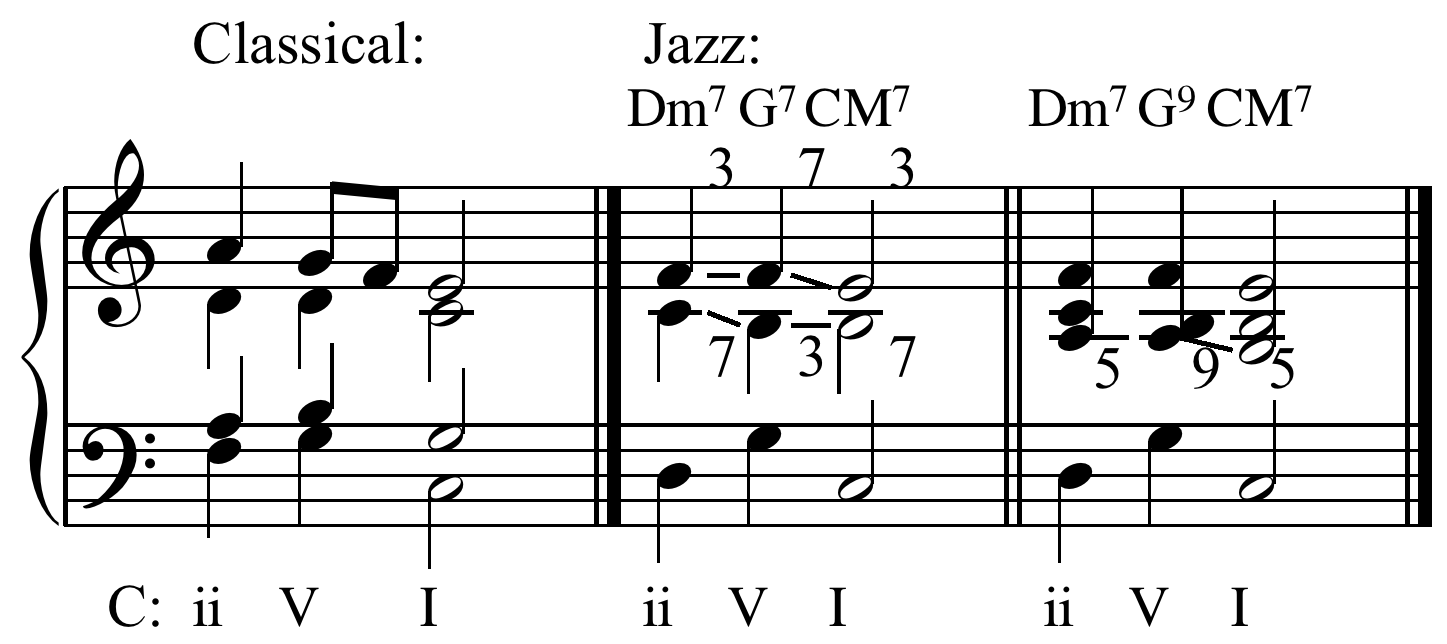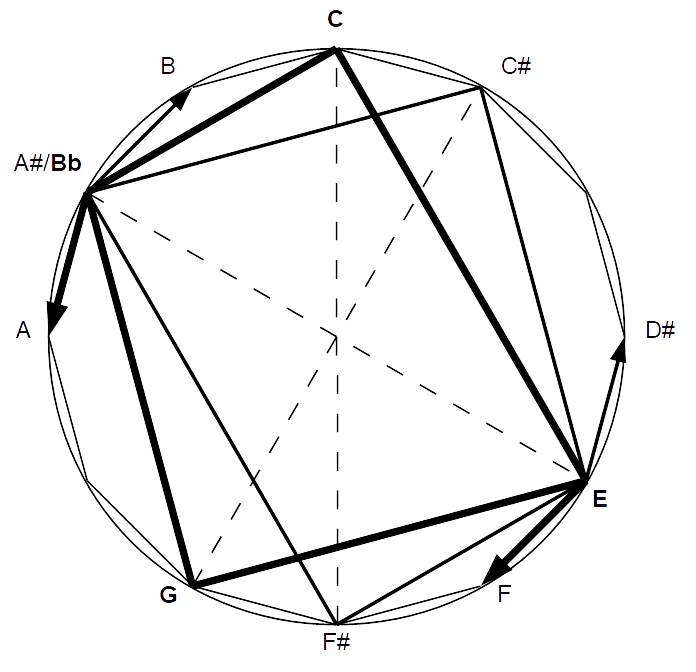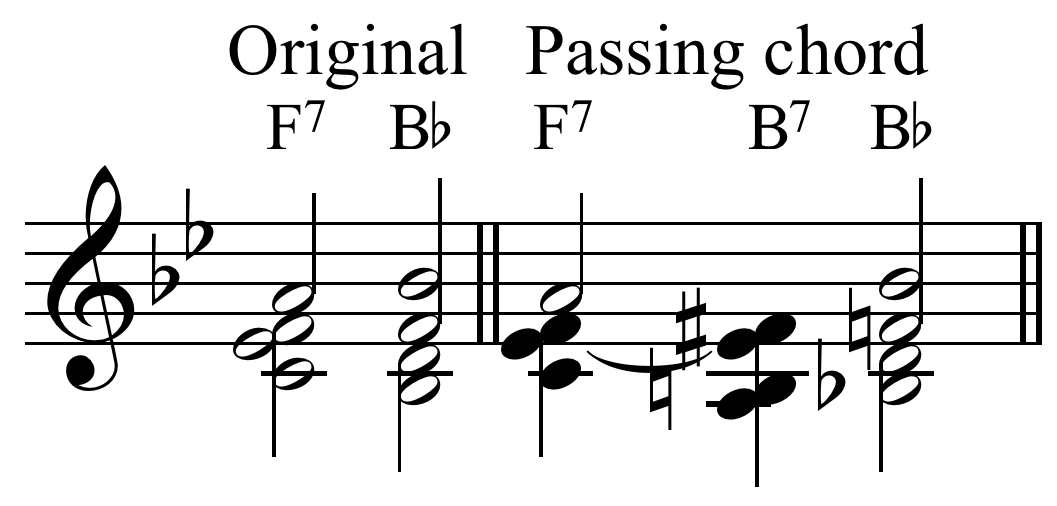|
Ii–V–I Progression
The ii–V–I progression ("two–five–one progression") (occasionally referred to as ii–V–I turnaround, and ii–V–I) is a common cadential chord progression used in a wide variety of music genres, including jazz harmony. It is a succession of chords whose roots descend in fifths from the second degree (supertonic) to the fifth degree ( dominant), and finally to the tonic. In a major key, the supertonic triad (ii) is minor, and in a minor key it is diminished. The dominant is, in its normal form, a major triad and commonly a dominant seventh chord. With the addition of chord alterations, substitutions, and extensions, limitless variations exist on this simple formula. The ii–V–I progression is "a staple of virtually every type of esternpopular music", including jazz, R&B, pop, rock, and country.Workman, Josh. "Chops: II–V–I Survival Tips", ''Guitar Player'' 37:4 (April 2003), p. 90. Examples include " Honeysuckle Rose" (1928), which, "features several bars ... [...More Info...] [...Related Items...] OR: [Wikipedia] [Google] [Baidu] |
Cadence
In Western musical theory, a cadence (Latin ''cadentia'', "a falling") is the end of a phrase in which the melody or harmony creates a sense of full or partial resolution, especially in music of the 16th century onwards.Don Michael Randel (1999). ''The Harvard Concise Dictionary of Music and Musicians'', pp. 105-106. . A harmonic cadence is a progression of two or more chords that concludes a phrase In syntax and grammar, a phrase is a group of words or singular word acting as a grammatical unit. For instance, the English expression "the very happy squirrel" is a noun phrase which contains the adjective phrase "very happy". Phrases can consi ..., section (music), section, or composition (music), piece of music. A rhythmic cadence is a characteristic rhythmic pattern that indicates the end of a phrase. A cadence can be labeled "weak" or "strong" depending on the impression of finality it gives. While cadences are usually classified by specific chord or melodic progressions, ... [...More Info...] [...Related Items...] OR: [Wikipedia] [Google] [Baidu] |
Honeysuckle Rose (song)
"Honeysuckle Rose" is a 1929 song composed by Fats Waller with lyrics by Andy Razaf. It was introduced in the 1929 Off-Broadway revue "Load of Coal" at Connie's Inn as a soft-shoe dance number. Waller's 1934 recording was inducted in the Grammy Hall of Fame in 1999. During a visit to the West Side of Asbury Park, New Jersey in 1928, Waller wrote the song with Razaf at 119 Atkins Avenue in a home that still stands today. Renditions *Fletcher Henderson (1932) *Fats Waller (1934), (1937) and (1941)"Honeysuckle Rose" sung by Fats Waller in a 1941 Minoco Production soundie (video) * (1935, originally issued on COL 3059-D) * |
Oswald Jonas
Oswald Jonas (January 10, 1897 – March 19, 1978) was a music theorist and musicologist and student of Heinrich Schenker. Despite Schenker's conservative nationalist views Jonas was an admirer of Karl Kraus. In 1935, Jonas founded the Schenker Institut and began publishing ''Der Dreiklang'' with Felix Salzer. The Oswald Jonas Memorial Collection, housed at the University of California, Riverside Library, holds the complete diaries of Schenker and much of the correspondence and manuscripts of Erwin Ratz, Jonas's first student. His primary students include Felix Salzer, Ernst Oster, and Sylvan Kalib. He taught at Roosevelt University in Chicago from 1941 to 1964 and then until his death at the University of California Riverside, where his materials as well as Schenker's ''Nachlass'' is deposited in the Special Collections Library. See also *Klang (music) *Schenkerian analysis Schenkerian analysis is a method of analyzing tonal music based on the theories of Heinrich Schenker (18 ... [...More Info...] [...Related Items...] OR: [Wikipedia] [Google] [Baidu] |
Enharmonic
In modern musical notation and tuning, an enharmonic equivalent is a note, interval, or key signature that is equivalent to some other note, interval, or key signature but "spelled", or named differently. The enharmonic spelling of a written note, interval, or chord is an alternative way to write that note, interval, or chord. The term is derived from Latin ''enharmonicus'', from Late Latin ''enarmonius'', from Ancient Greek ἐναρμόνιος (''enarmónios''), from ἐν (''en'') and ἁρμονία (''harmonía''). Definition For example, in any twelve-tone equal temperament (the predominant system of musical tuning in Western music), the notes C and D are ''enharmonic'' (or ''enharmonically equivalent'') notes. Namely, they are the same key on a keyboard, and thus they are identical in pitch, although they have different names and different roles in harmony and chord progressions. Arbitrary amounts of accidentals can produce further enharmonic equivalents, such as B (me ... [...More Info...] [...Related Items...] OR: [Wikipedia] [Google] [Baidu] |
Tritone Substitution
The tritone substitution is a common chord substitution found in both jazz and classical music. Where jazz is concerned, it was the precursor to more complex substitution patterns like Coltrane changes. Tritone substitutions are sometimes used in improvisation—often to create tension during a solo. Though examples of the tritone substitution, known in the classical world as an augmented sixth chord, can be found extensively in classical music since the Renaissance period, they were not heard until much later in jazz by musicians such as Dizzy Gillespie and Charlie Parker in the 1940s, as well as Duke Ellington, Art Tatum, Coleman Hawkins, Roy Eldridge and Benny Goodman. The tritone substitution can be performed by exchanging a dominant seventh chord for another dominant seven chord which is a tritone away from it. For example, in the key of C major one can use D7 instead of G7. (D is a tritone away from G). Summary In tonal music, a conventional perfect cadence consists of a ... [...More Info...] [...Related Items...] OR: [Wikipedia] [Google] [Baidu] |
Voice Leading
Voice leading (or part writing) is the linear progression of individual melodic lines ( voices or parts) and their interaction with one another to create harmonies, typically in accordance with the principles of common-practice harmony and counterpoint. Rigorous concern for voice leading is of greatest importance in common-practice music, although jazz and pop music also demonstrate attention to voice leading to varying degrees. In ''Jazz Theory'', Gabriel Sakuma writes that " the surface level, jazz voice-leading conventions seem more relaxed than they are in common-practice music."Terefenko, Dariusz (2014). ''Jazz Theory: From Basic to Advanced Study'', p. 33. Routledge. . Marc Schonbrun also states that while it is untrue that "popular music has no voice leading in it, ..the largest amount of popular music is simply conceived with chords as blocks of information, and melodies are layered on top of the chords."Schonbrun, Marc (2011). ''The Everything Music Theory Book'', pp. 1 ... [...More Info...] [...Related Items...] OR: [Wikipedia] [Google] [Baidu] |
Turnaround (music)
In jazz, a turnaround is a passage at the end of a section which leads to the next section. This next section is most often the repetition of the previous section or the entire piece or song.Randel, Don Michael (2002). ''The Harvard Concise Dictionary of Music and Musicians''. . p.693 The turnaround may lead back to this section either harmonically, as a chord progression, or melodically. Typical examples Typical turnarounds in jazz include: *I–vi–ii–V ( ii–V–I turnaround, circle progression) *I-VI-ii-V *I–VI–II–V (I–V/ii–V/V–V) *I–iii–ii7–V7 *I–vi–VI711–V * V–IV–I (blues turnaround) *I–III–VI–II7 (Tadd Dameron turnaround) *iii-VI-ii-V Turnarounds typically begin with the tonic (I) (or a tonic substitute such as iii) and end on the dominant (V7), the next section starting on the tonic (I). They may also end on II7 (which is a dominant substitute). Thus when used in a twelve bar blues pattern, the twelfth bar may end on the do ... [...More Info...] [...Related Items...] OR: [Wikipedia] [Google] [Baidu] |
Blues Cadence
Blues is a music genre and musical form which originated in the Deep South of the United States around the 1860s. Blues incorporated spirituals, work songs, field hollers, shouts, chants, and rhymed simple narrative ballads from the African-American culture. The blues form is ubiquitous in jazz, rhythm and blues, and rock and roll, and is characterized by the call-and-response pattern (the blues scale and specific chord progressions) of which the twelve-bar blues is the most common. Blue notes (or "worried notes"), usually thirds, fifths or sevenths flattened in pitch, are also an essential part of the sound. Blues shuffles or walking bass reinforce the trance-like rhythm and form a repetitive effect known as the groove. Blues as a genre is also characterized by its lyrics, bass lines, and instrumentation. Early traditional blues verses consisted of a single line repeated four times. It was only in the first decades of the 20th century that the most common current st ... [...More Info...] [...Related Items...] OR: [Wikipedia] [Google] [Baidu] |
Twelve-bar Blues
The 12-bar blues (or blues changes) is one of the most prominent chord progressions in popular music. The blues progression has a distinctive form in lyrics, phrase, chord structure, and duration. In its basic form, it is predominantly based on the I, IV, and V chords of a key. Mastery of the blues and rhythm changes are "critical elements for building a jazz repertoire". Background The blues originated from a combination of work songs, spirituals, and early southern country music. The music was passed down through oral tradition. It was first written down by W. C. Handy, an African American composer and band leader. Its popularity led to the creation of "race records" and the popularity of blues singers like Bessie Smith and Ma Rainy. The style of music heard on race records was later called "rhythm and blues" (R & B). As the music became more popular, more people wanted to perform it. General patterns that existed in the blues were formalized, one of these being the 12-bar ... [...More Info...] [...Related Items...] OR: [Wikipedia] [Google] [Baidu] |
Blues
Blues is a music genre and musical form which originated in the Deep South of the United States around the 1860s. Blues incorporated spirituals, work songs, field hollers, shouts, chants, and rhymed simple narrative ballads from the African-American culture. The blues form is ubiquitous in jazz, rhythm and blues, and rock and roll, and is characterized by the call-and-response pattern (the blues scale and specific chord progressions) of which the twelve-bar blues is the most common. Blue notes (or "worried notes"), usually thirds, fifths or sevenths flattened in pitch, are also an essential part of the sound. Blues shuffles or walking bass reinforce the trance-like rhythm and form a repetitive effect known as the groove. Blues as a genre is also characterized by its lyrics, bass lines, and instrumentation. Early traditional blues verses consisted of a single line repeated four times. It was only in the first decades of the 20th century that the most common current str ... [...More Info...] [...Related Items...] OR: [Wikipedia] [Google] [Baidu] |
Passing Chord
In music, a passing chord is a chord that connects, or passes between, the notes of two diatonic chords. "Any chord that moves between one diatonic chord and another one nearby may be loosely termed a passing chord. A diatonic passing chord may be inserted into a pre-existing progression that moves by a major or minor third in order to create more movement."Rawlins and Bahha (2005). ''Jazzology: The Encyclopedia of Jazz Theory for All Musicians'', p.104. . "'Inbetween chords' that help you get from one chord to another are called passing chords."Sokolow, Fred (2002). ''Jazzing It Up'', p.9. . For example, in the simple chord progression in the key of C Major, which goes from I7/iii7/ii7/V7: , Cmaj7 , Em7 , Dm7 , G7 , the diatonic (this means "from the scale of the tonic") passing chord (Dm7) may be inserted: , Cmaj7 Dm7 , Em7 , Dm7 , G7 , or the chromatic passing chord (Ebm7) may be inserted: , Cmaj7 , Em7 Ebm7 , Dm7 , G7 , or one or mo ... [...More Info...] [...Related Items...] OR: [Wikipedia] [Google] [Baidu] |




